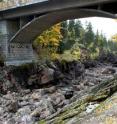The creation of the Vuoksi River preceded a significant cultural shift
The creation of the Vuoksi River and the subsequent rapid decrease in the water level of Lake Saimaa approximately 6,000 years ago revealed thousands of square kilometres of new, fertile land in eastern Finland. A multidisciplinary research project organised by University of Helsinki researchers has studied the role that the decrease in water levels has played in the interaction between nature and humans. After dramatic shifts in the waterways, human life in the area underwent significant changes and gave rise to a new, innovative culture. This stemmed from an increase in the elk population, which flourished on the pioneer flora growing on the newly emerged land. Later, the culture regressed as the ecosystem in the area shifted towards old-growth spruce-dominated forests which could not maintain the large elk population. After the end of the last ice age, post-glacial rebound caused the Earth's crust in eastern Fenno-Scandinavia to tilt, increasing the amount of water and size of the body of water that would later become Lake Saimaa. Approximately 6,000 years ago, the Salpausselkä ridge could no longer hold back the waters, which burst through and penetrated the glacial till and bedrock with incredible force. This created the Vuoksi River, and resulted in an approximately four-metre decrease in the water level of Lake Saimaa, revealing thousands of square kilometres of new land in Eastern Finland.
Run by University of Helsinki biologists, scientists and archaeologists together with the National Board of Antiquities, the Finnish Game and Fisheries Research Institute and the University of Bristol, the multidisciplinary research project has studied the role which the creation of the Vuoksi River played in the simultaneous spread of the most significant culture in our prehistory.
One of the basic principles of science is that the cause must come before the effect, emphasises Docent Markku Oinonen, who is the director of the Natural Sciences Unit of the Finnish Museum of Natural History, a University of Helsinki independent institute.
The research is based on probable sequences of events indicated by radiocarbon and Bayesian dating, which suggest that Vuoksi was created a few decades before the culture in the area changed. After the emergence of the river, the culture which used asbestos in its pottery disappeared and was replaced by an innovative culture which employed timber housing, flint and amber -- as is typical of the Pit-Comb Ware culture.
Electron microscope analyses of the pottery together with stylistic differences of the pieces themselves and the eradication of the solidifying asbestos in the pottery indicate that distinct changes in pottery-making occurred.
The archaeological study of bones in the area reveals that the significance of elk as game was much greater in the emerging culture compared with the cultures that came before or after it. Another factor in the changes may have been the near-simultaneous spread of eastern spruce trees, which continue to be the dominant tree in the area.
We are beginning to understand how pioneer growth on the emerging land increased the elk population, which attracted people who had new ways of working and enabled the increase in the human population," Oinonen explains.
The spread of typical Pit-Comb Ware culture to the Saimaa region is related to the wider phenomenon of the Stone Age population maximum, i.e., the stage when the population in Finland was at its largest. The new culture was at its peak for a few centuries and regressed as the ecosystem became dominated by old-growth spruce forests which provided a less ideal elk habitat than the recently-emerged land.
Source: University of Helsinki
Other sources
- Creation of the Vuoksi River preceded a significant cultural shiftfrom Science DailyTue, 16 Sep 2014, 10:08:38 UTC
- The creation of the Vuoksi River preceded a significant cultural shiftfrom PhysorgMon, 15 Sep 2014, 15:31:08 UTC
